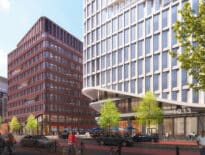
Established retail corridors such as Back Bay’s Newbury Street can sustain themselves with a mix of revenues from visitors and neighborhood residents. iStock photo
Let’s face it, retail can thrive or fail depending on a multitude of factors. Community-based retail is having a resurgence even with the digital world as it is today. People are yearning for more face-to-face interaction.
As consultants who’ve worked on the conception, coordination and promotion of large-scale, transformative, place-making developments, we know that retail is one of the primary elements that drives interest in a pending project. We hear the question constantly: “What’s going into the retail space?”
Well-selected retail options create excitement and elevate the profile of a development. In fact, there’s a prevalent argument that leaning more into the retail aspects of a project during the entitlements phase may help smooth out the process. This is a win-win area where developers can inspire buy-in from the entire landscape of stakeholders.
The economic implications of a thriving ground floor experience extend well beyond the first lease year, affecting the success of renewal rates, capital outlay toward turnover-costs and refinancing or cashing out of an asset on track with pro forma.
Here is our guide to creating neighborhood magnets with major gravitational pull.
Identify Your Corridor
There are five types of retail corridors, and identifying yours is critical when planning your ground floor. We measure these corridors on a scale, with Unestablished or Failing corridors at the bottom, and the Self-Sustaining Corridor at the top.
Unestablished or Failing corridors lack basic retail amenities. Occupants must leave their immediate vicinity to meet the bulk of their daily needs, and their dollars go with them.
Next comes the Bare Minimum Corridor. This corridor provides certain retail essentials, such that occupants can fulfill some daily needs onsite, but their leisure dollars are still being spent elsewhere.
The Engaged Community Corridor marks a significant turning point, with retail and food and beverage amenities that improve the daily quality of life. Leisure dollars increasingly stay in the neighborhood, sparking measurable economic development. As this trend continues, visitors from other neighborhoods or districts are attracted to the location. Outside dollars are now streaming in, and the area becomes a Revenue-Producing Corridor.
Finally, after a sustained period of revenue production, demand is cemented. Retail rents consistently grow, and the market becomes a Self-Sustaining Corridor with durable financial performance.
Because of where sites available for development tend to be in dense urban markets, most of the projects we work on start as Unestablished/Failing or Bare Minimum corridors. Our programs power their transformation through the following strategies:

Ann Ehrhart
Engage Your Audience
Conventional retail models often exclude the primary decision-maker in the success of corridor – the community. While the landlord or developer builds the physical space, the community decides whether they walk through the front door. Understanding your unique audience pays dividends.
But what sort of shops do that best? While there are always the tried-and-true big-name options that can be found in virtually every region of the country, we’d suggest establishing a more distinctive identity by focusing on two particular retail types: women-owned and minority-owned businesses.
According to a 2019 report by Forbes, women influence or control up to 85 percent of consumer spending in the U.S. Retail locations owned by women are often well-positioned to recognize what is valued, what is missing, and what is needed.
In our diverse world, it’s also smart to identify retail outlets that target the needs of traditionally under-represented consumers.
Millennials are now the largest generation in the U.S. workforce, and when combined with Generation Z, they make up over half of the nation’s population. This group of consumers forms the most ethnically and racially diverse adult group in U.S. history, and studies have shown that when faced with two retailers to choose from, 69 percent of Millennials and their younger peers will choose the brand that demonstrates a stronger commitment to diversity.

Carolyn Spicer
Sync Merchandising, Design and Pro Forma
While the benefits of working with local, smaller-scale retailers are clear, successfully executing a merchandising mix rich in minority- and women-owned small businesses requires intentionality and attention to detail at each step.
So how to do it? Start with a focused planning phase that leverages the understanding of your corridor to sync merchandising, design and pro forma.
Target a merchandising mix that considers existing neighbors of the site and those you wish to attract. What retail uses will improve their daily lived experience in the location?
The importance of contextual design cannot be overlooked. If your targeted merchants perform best in smaller storefronts with character, this is not the place to deliver a large, deep space with anonymous ribbons of glass-and-aluminum storefront.
Underwrite rental rates based on the sales volumes you want to see your street level achieve. Rents will follow. Prioritizing top-dollar rents on the ground floor makes it challenging to attract community-engaging tenants, hindering sales volumes. We’ve witnessed projects take a full cycle to recover from this misaligned approach.
Ann Ehrhart is founder and CEO of Boston-based Everstreet and Carolyn Spicer is president of McDermott Ventures.





